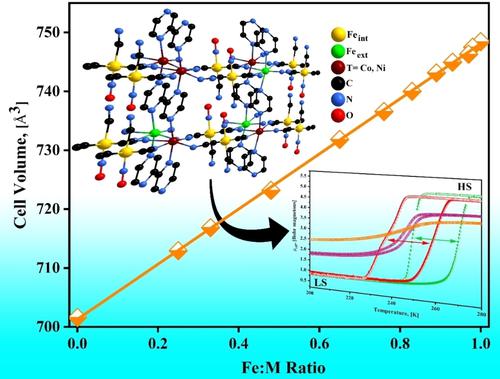当前位置:
X-MOL 学术
›
Eur. J. Inorg. Chem.
›
论文详情
Our official English website, www.x-mol.net, welcomes your
feedback! (Note: you will need to create a separate account there.)
Thermally-Induced Spin-Crossover in Fe1-xTx(pyrazine)[Fe(CN)5NO] with T=Co, Ni – Effects of Iron Atom Dilution
European Journal of Inorganic Chemistry ( IF 2.2 ) Pub Date : 2021-09-02 , DOI: 10.1002/ejic.202100593 Yosuan Avila 1 , Ricardo Terrero 2 , Paula M. Crespo 1 , Luis A. Díaz Paneque 1 , Marlene Gonzalez 1 , Manuel Avila 1 , Edilso Reguera 3
European Journal of Inorganic Chemistry ( IF 2.2 ) Pub Date : 2021-09-02 , DOI: 10.1002/ejic.202100593 Yosuan Avila 1 , Ricardo Terrero 2 , Paula M. Crespo 1 , Luis A. Díaz Paneque 1 , Marlene Gonzalez 1 , Manuel Avila 1 , Edilso Reguera 3
Affiliation

|
2D ferrous nitroprusside with the pyrazine molecule as a pillar between adjacent layers shows a thermally induced spin-crossover behavior. This supposes that the energy gap between the high and low spin states is the order of kT in the temperature region where such a spin transition is observed. If a fraction of the iron atoms involved in that transition is progressively replaced by a second metal, to form a solid solution (alloy), the thermal effect could be modified due to the iron atom dilution, but such behavior also depends on the bonding properties of the ligands for the iron atom and of the NO and CN interaction in the interlayer region. This hypothesis was the idea that motivated the preparation of the titled systems of solid solutions and their study from magnetic and Mössbauer data recorded at different temperatures in the range of 5–300 K, complemented with XRD, Raman, and IR measurements. Co and Ni were considered to form the solid solutions under study because they form isostructural solids in the parent 3D coordination polymers. For both metals, the formed solids show a spin-crossover effect for all the compositions range but from a certain degree of dilution for the iron atom, above 75 % substitution by the second metal, the thermal hysteresis almost disappears. This suggests that from that dilution degree, the spin transition involves structural changes at the local coordination environment for the iron atom but not for the entire solid framework. This hypothesis is properly supported by the recorded Raman and Mössbauer spectra. The presence of Co and Ni atoms in the solid solutions results in higher stability for the entropy-driven high spin state. This is appreciated as lower values for T↓HS,1/2, and T↑LS,1/2 corresponding to the temperatures where the subscript 1/2 indicates the temperature where 50 % of the metal centers have changed their spin state.
中文翻译:

Fe1-xTx(pyrazine)[Fe(CN)5NO] 中 T=Co、Ni 的热诱导自旋交叉——铁原子稀释的影响
以吡嗪分子作为相邻层之间的支柱的 2D 硝普亚铁显示出热诱导的自旋交叉行为。这假设在观察到这种自旋跃迁的温度范围内,高自旋态和低自旋态之间的能隙是 kT 的数量级。如果参与该转变的一小部分铁原子逐渐被第二种金属取代以形成固溶体(合金),则热效应可能会由于铁原子的稀释而改变,但这种行为也取决于键合特性层间区域中铁原子的配体和 NO 和 CN 相互作用的分析。这一假设激发了固体溶液体系的制备及其研究,这些数据是在 5-300 K 范围内的不同温度下记录的磁性和穆斯堡尔数据,并辅以 XRD、拉曼和红外测量。Co 和 Ni 被认为形成了所研究的固溶体,因为它们在母体 3D 配位聚合物中形成同构固体。对于这两种金属,所形成的固体在所有组成范围内都显示出自旋交叉效应,但从铁原子的一定程度稀释,到被第二种金属取代 75% 以上,热滞后几乎消失。这表明,从这种稀释程度来看,自旋转变涉及铁原子局部配位环境的结构变化,而不是整个固体骨架。这一假设得到了记录的拉曼和穆斯堡尔光谱的正确支持。固溶体中 Co 和 Ni 原子的存在导致熵驱动的高自旋状态具有更高的稳定性。这被认为是 T↓ 的较低值HS , 1/2 , 和 T↑ LS , 1/2对应于温度,其中下标 1/2 表示 50% 的金属中心改变了它们的自旋状态的温度。
更新日期:2021-09-14
中文翻译:

Fe1-xTx(pyrazine)[Fe(CN)5NO] 中 T=Co、Ni 的热诱导自旋交叉——铁原子稀释的影响
以吡嗪分子作为相邻层之间的支柱的 2D 硝普亚铁显示出热诱导的自旋交叉行为。这假设在观察到这种自旋跃迁的温度范围内,高自旋态和低自旋态之间的能隙是 kT 的数量级。如果参与该转变的一小部分铁原子逐渐被第二种金属取代以形成固溶体(合金),则热效应可能会由于铁原子的稀释而改变,但这种行为也取决于键合特性层间区域中铁原子的配体和 NO 和 CN 相互作用的分析。这一假设激发了固体溶液体系的制备及其研究,这些数据是在 5-300 K 范围内的不同温度下记录的磁性和穆斯堡尔数据,并辅以 XRD、拉曼和红外测量。Co 和 Ni 被认为形成了所研究的固溶体,因为它们在母体 3D 配位聚合物中形成同构固体。对于这两种金属,所形成的固体在所有组成范围内都显示出自旋交叉效应,但从铁原子的一定程度稀释,到被第二种金属取代 75% 以上,热滞后几乎消失。这表明,从这种稀释程度来看,自旋转变涉及铁原子局部配位环境的结构变化,而不是整个固体骨架。这一假设得到了记录的拉曼和穆斯堡尔光谱的正确支持。固溶体中 Co 和 Ni 原子的存在导致熵驱动的高自旋状态具有更高的稳定性。这被认为是 T↓ 的较低值HS , 1/2 , 和 T↑ LS , 1/2对应于温度,其中下标 1/2 表示 50% 的金属中心改变了它们的自旋状态的温度。











































 京公网安备 11010802027423号
京公网安备 11010802027423号